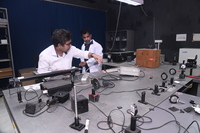Welcome To Non–Linear Optics and LASER Spectroscopy Research Laboratory
Overview:
Nonlinear Optics and
Laser Spectroscopy laboratory started functioning immediately after the
completion of construction of the first phase for Center for Advanced Research
in Sciences (CARS), in early 2005. The main reason behind the establishment of
this laboratory was exactly the same to the reason behind the establishment of
the center (CARS) that was to create advanced research facilities to pursue
research in the frontiers of science and to provide the faculty members access
to these facilities. Amazing advances are being made by using high power
ultra-short laser pulses in spectroscopy. Because of the progress mentioned
above and an increased sophistication of research in lasers and quantum optics
for last few decades and in particular the lack of state of the art technology
equipment, which became very expensive for the university to provide to its
researchers in different departments or in individual groups. A nonlinear
optics and laser spectroscopy lab was established in the center, to do the
advance research in the field of lasers and modern optics.
Research Area:
§ Laser
Induced Breakdown Spectroscopy(LIBS) for elemental analysis
§ Raman
Spectroscopy as well as Surface Enhanced Raman Spectroscopy(SERS)
§ Formation
of nanoparticles and sub-nanostructures

Facilities:
- Q-Switched Nd:YAG Laser (Spectra Physics U.S.A: Fundamental @ 1064 nm with harmonic generations facilities upto 4th order)
- CW Argon-Ion Laser
- CW He-Ne Laser
- CW Diode Laser
- Nd:YAG laser pumped Optical Parametric Oscillator (OPO)
- Spectrograph (Pro 2750 Sp 2758) coupled with CCD camera (Princeton Instruments, USA)
- Spectrograph with Intensified and Gated CCD Camera
- High duty Industrial Chiller
- Optics and Mounts for the Optics (Mirrors, Lenses, etc.)
- Laser Power Meter
- Optical Bench with breadboard (1) and Breadboard top (2)
- bScope Trinocular Microscope with camera( Model: BS-1153-EPLi)
- Spin
Coater
Personnel:
Dr. Mohammad Abdul Matin
Publications:
| Sl. | Article | Type | Year | Link |
|---|---|---|---|---|
| 1 | Modulation of optical nonlinearity of silver nanoparticles by 2D ZnO nanoflakes, Tanvir Ahmed , Pulak Das Gupta , Zulfiqar Hasan Khan , Harinarayan Das, Tasnim Akbar Faruquee , Mahabub Alam Bhuiyan, Syed Farid Uddin Farhad, Ishtiaque M. Syed , Aminul I. Talukder, Md. Wahadoszamen , Results in Physics, Vol. 64, 2024, 107889 | Journal | 2024 | Link |
| 2 | Laser-Induced Breakdown Spectroscopy (LIBS) for Trace Element Detection: A Review. Z. H. Khan, M. H. Ullah, B. Rahman, A. I. Talukder, Md. Wahadoszamen, K M Abedin, A F M. Y Haider, Journal of Spectroscopy. 2022,1-25 (2022). | Journal | 2022 | Link |
| 3 | Estimation of prolonged lifetimes of excited states of neutral oxygen atom (OI) by time-resolved laser-induced breakdown spectroscopy (TR-LIBS), Abul Fazal Mohammed Yusuf Haider1,3, Nabil Md Rakinul Hoque2, Arifur Rahaman and Zulfiqar Hasan Khan, Journal of Bangladesh Academy of Sciences 46 (2), 175-184 (2022). | Journal | 2022 | Link |
| 4 | Highly sensitive detection of lead in aqueous solution using laser-induced breakdown spectroscopy coupled with adsorption technique, A.F.M.Y. Haider, M. Parvin, Z. H. Khan and M. Wahadoszamen, Journal of Applied Spectroscopy, 87(6), pp.1163-1170(2021). | Journal | 2021 | Link |
| 5 | Economically reproducible surface-enhanced Raman spectroscopy of different compounds in thin film. A. Islam, F. Tasneem, Z. H. Khan, A. Rakib, S F U Farhad, A. I. Talukder, AFMY Haider, and Md Wahadoszamen. Journal of Bangladesh Academy of Sciences 45 (1), 1-11 (2021). | Journal | 2021 | Link |
| 6 | A Rapid Method of Identification of Garnet in Beach Sands Using Laser-Induced Breakdown Spectroscopy, F. Tasneem, Z. H. Khan, A. Islam, N. Faiza, S. Kabir, A. Talukder, A. F. M. Y. Haider, M Wahadoszamen, Journal of Bangladesh Academy of Sciences, 43(2), 149-157 (2020). | Journal | 2020 | Link |
| 7 | Identification of multiple rare earths and other associated elements in zircon by laser-induced breakdown spectroscopy. AFMY Haider and Z H Khan. Journal of Bangladesh Academy of Sciences 44(1), 59-68 (2020); | Journal | 2020 | Link |
